
Supervised learning (SL) is a paradigm in machine learning where input objects and a desired output value train a model. The training data is processed, building a function that maps new data on expected output values. An optimal scenario will allow for the algorithm to correctly determine output values for unseen instances. This requires the learning algorithm to generalize from the training data to unseen situations in a "reasonable" way. This statistical quality of an algorithm is measured through the so-called generalization error.

In machine learning, a neural network is a model inspired by the neuronal organization found in the biological neural networks in animal brains.
Pattern recognition is the task of assigning a class to an observation based on patterns extracted from data. While similar, pattern recognition (PR) is not to be confused with pattern machines (PM) which may possess (PR) capabilities but their primary function is to distinguish and create emergent pattern. PR has applications in statistical data analysis, signal processing, image analysis, information retrieval, bioinformatics, data compression, computer graphics and machine learning. Pattern recognition has its origins in statistics and engineering; some modern approaches to pattern recognition include the use of machine learning, due to the increased availability of big data and a new abundance of processing power.
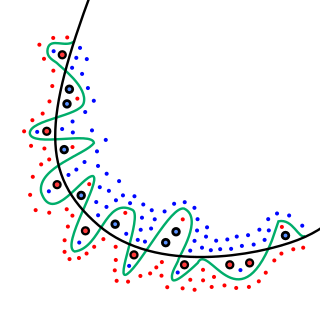
In mathematical modeling, overfitting is "the production of an analysis that corresponds too closely or exactly to a particular set of data, and may therefore fail to fit to additional data or predict future observations reliably". An overfitted model is a mathematical model that contains more parameters than can be justified by the data. In a mathematical sense, these parameters represent the degree of a polynomial. The essence of overfitting is to have unknowingly extracted some of the residual variation as if that variation represented underlying model structure.
In machine learning, early stopping is a form of regularization used to avoid overfitting when training a learner with an iterative method, such as gradient descent. Such methods update the learner so as to make it better fit the training data with each iteration. Up to a point, this improves the learner's performance on data outside of the training set. Past that point, however, improving the learner's fit to the training data comes at the expense of increased generalization error. Early stopping rules provide guidance as to how many iterations can be run before the learner begins to over-fit. Early stopping rules have been employed in many different machine learning methods, with varying amounts of theoretical foundation.
Machine learning (ML) is a field of study in artificial intelligence concerned with the development and study of statistical algorithms that can learn from data and generalize to unseen data, and thus perform tasks without explicit instructions. Recently, artificial neural networks have been able to surpass many previous approaches in performance.
In Vapnik–Chervonenkis theory, the Vapnik–Chervonenkis (VC) dimension is a measure of the size of a class of sets. The notion can be extended to classes of binary functions. It is defined as the cardinality of the largest set of points that the algorithm can shatter, which means the algorithm can always learn a perfect classifier for any labeling of at least one configuration of those data points. It was originally defined by Vladimir Vapnik and Alexey Chervonenkis.

Cross-validation, sometimes called rotation estimation or out-of-sample testing, is any of various similar model validation techniques for assessing how the results of a statistical analysis will generalize to an independent data set. Cross-validation includes resampling and sample splitting methods that use different portions of the data to test and train a model on different iterations. It is often used in settings where the goal is prediction, and one wants to estimate how accurately a predictive model will perform in practice. It can also be used to assess the quality of a fitted model and the stability of its parameters.
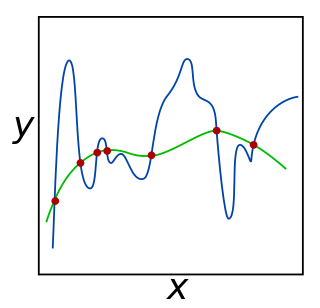
In mathematics, statistics, finance, computer science, particularly in machine learning and inverse problems, regularization is a process that changes the result answer to be "simpler". It is often used to obtain results for ill-posed problems or to prevent overfitting.
Neural gas is an artificial neural network, inspired by the self-organizing map and introduced in 1991 by Thomas Martinetz and Klaus Schulten. The neural gas is a simple algorithm for finding optimal data representations based on feature vectors. The algorithm was coined "neural gas" because of the dynamics of the feature vectors during the adaptation process, which distribute themselves like a gas within the data space. It is applied where data compression or vector quantization is an issue, for example speech recognition, image processing or pattern recognition. As a robustly converging alternative to the k-means clustering it is also used for cluster analysis.
Structural risk minimization (SRM) is an inductive principle of use in machine learning. Commonly in machine learning, a generalized model must be selected from a finite data set, with the consequent problem of overfitting – the model becoming too strongly tailored to the particularities of the training set and generalizing poorly to new data. The SRM principle addresses this problem by balancing the model's complexity against its success at fitting the training data. This principle was first set out in a 1974 book by Vladimir Vapnik and Alexey Chervonenkis and uses the VC dimension.
In statistics and machine learning, ensemble methods use multiple learning algorithms to obtain better predictive performance than could be obtained from any of the constituent learning algorithms alone. Unlike a statistical ensemble in statistical mechanics, which is usually infinite, a machine learning ensemble consists of only a concrete finite set of alternative models, but typically allows for much more flexible structure to exist among those alternatives.
Error-driven learning is a type of reinforcement learning method. This method tweaks a model’s parameters based on the difference between the proposed and actual results. These models stand out as they depend on environmental feedback instead of explicit labels or categories. They are based on the idea that language acquisition involves the minimization of the prediction error (MPSE). By leveraging these prediction errors, the models consistently refine expectations and decrease computational complexity. Typically, these algorithms are operated by the GeneRec algorithm.
There are many types of artificial neural networks (ANN).
In machine learning, a hyperparameter is a parameter, such as the learning rate or choice of optimizer, which specifies details of the learning process, hence the name hyperparameter. This is in contrast to parameters which determine the model itself.
Convolutional neural network (CNN) is a regularized type of feed-forward neural network that learns feature engineering by itself via filters optimization. Vanishing gradients and exploding gradients, seen during backpropagation in earlier neural networks, are prevented by using regularized weights over fewer connections. For example, for each neuron in the fully-connected layer, 10,000 weights would be required for processing an image sized 100 × 100 pixels. However, applying cascaded convolution kernels, only 25 neurons are required to process 5x5-sized tiles. Higher-layer features are extracted from wider context windows, compared to lower-layer features.

In statistics and machine learning, the bias–variance tradeoff describes the relationship between a model's complexity, the accuracy of its predictions, and how well it can make predictions on previously unseen data that were not used to train the model. In general, as we increase the number of tunable parameters in a model, it becomes more flexible, and can better fit a training data set. It is said to have lower error, or bias. However, for more flexible models, there will tend to be greater variance to the model fit each time we take a set of samples to create a new training data set. It is said that there is greater variance in the model's estimated parameters.
In machine learning, hyperparameter optimization or tuning is the problem of choosing a set of optimal hyperparameters for a learning algorithm. A hyperparameter is a parameter whose value is used to control the learning process.
Neural architecture search (NAS) is a technique for automating the design of artificial neural networks (ANN), a widely used model in the field of machine learning. NAS has been used to design networks that are on par or outperform hand-designed architectures. Methods for NAS can be categorized according to the search space, search strategy and performance estimation strategy used:
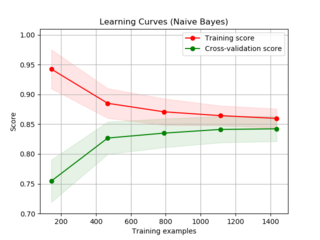
In machine learning, a learning curve plots the optimal value of a model's loss function for a training set against this loss function evaluated on a validation data set with same parameters as produced the optimal function. Synonyms include error curve, experience curve, improvement curve and generalization curve.

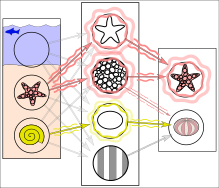
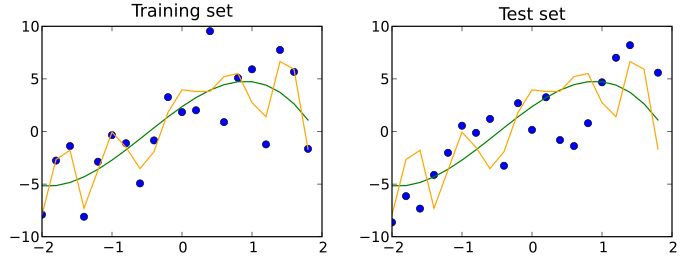
![Comic strip demonstrating a fictional erroneous computer output (making a coffee 5 million degrees [Celsius or Fahrenheit not specified], from a previous definition of "extra hot"). This can be classified as both a failure in logic and a failure to include various relevant environmental conditions. Computer definition of extra hot.png](http://upload.wikimedia.org/wikipedia/commons/thumb/1/1e/Computer_definition_of_extra_hot.png/260px-Computer_definition_of_extra_hot.png)






